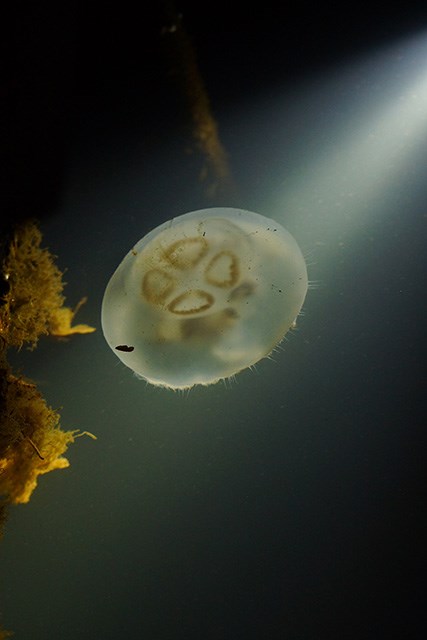Peer into the murky water of the Mamquam Blind Channel and chances are there will be jellyfish by the dozens.
The influx of jellyfish to the channel is really common at this time of year, according to Mackenzie Neale, assistant curator of propagation at the Vancouver Aquarium.
“This is kind of the end of the season for them and they are subject to currents, to wind… so often they get blown into channels,” she said, adding the jellyfish are full size at this time of year.
Jellyfish often also congregate at the mouth of a river, she said, because they are attracted to fresh water.
Soon the males and females in the channel will reproduce, she said. The jellyfish polyps, or babies, will then attach to rocks or docks, or any other type of sea structure.
The fried-egg jellyfish, which is usually big, white and has long tentacles and the moon jellyfish, which have a short, fine fringe are the most common jellyfish found locally.
Fried egg jellies are big fish eaters, which is why sometimes half eaten fish can be seen inside their translucent bodies.
“They have their long tentacles and they catch the prey and because of the venom and the stinging cells that they have, they immobilize the fish fairly quickly,” Neale said, adding the soft bits underneath the body are the mouths.
They also eat other jellyfish.
Moon jellyfish are the most common type of jellies in the world and are likely found in every ocean, Neale said.
For Squamish resident Darryl Schwanke, who often photographs the jellyfish in the Mamquam Blind Channel, it is the seeming vulnerability of the marine creatures that is fascinating.
“Like many sea creatures, they can appear so helpless and like nothing more than a blob on the beach, but then you see one living in its element, perfectly supported by the sea, and it’s suddenly a thing of beauty — full of life and purpose,” he said.
In general, jellyfish populations globally are increasing, Neale said, thanks in great part to the behaviour of humans. Climate change has led to an increase in temperature in the world’s oceans, which leads to jellyfish reproducing more. Increased pollution in the ocean is also tied to increased jellyfish as some chemicals in the water trigger their reproduction.
“We are [also] building more structures, such as docks and pilings, so we are providing more habitat for the polyps,” she added.
Overfishing is yet another reason for the global increase in jellyfish.
“Before, when we had higher fish stocks, those fish were eating plankton and that was keeping the jellyfish in check because it limited their food source.”
Research is currently underway to see what the ultimate impact of more jellyfish will have on the marine environment, Neale said.
For Neale, the coolest thing about jellyfish is that they have been around since likely before dinosaurs.
“They have been able to survive so many things,” she said.



